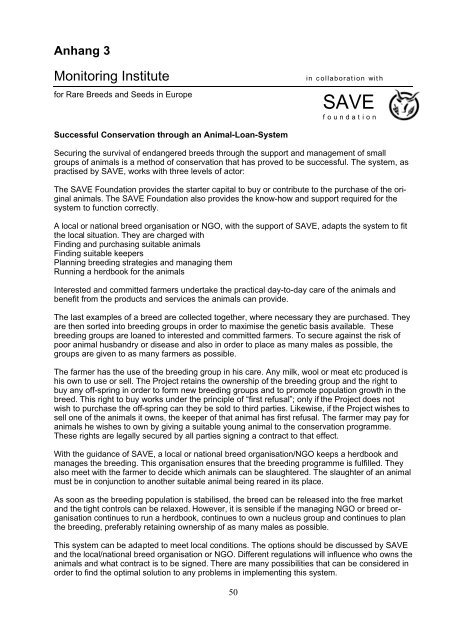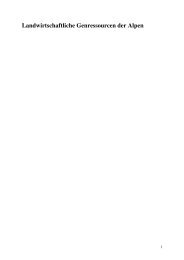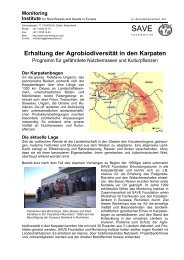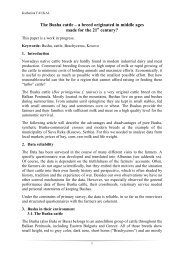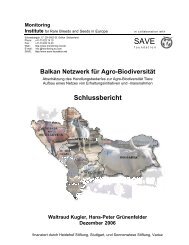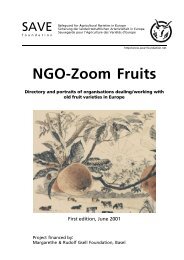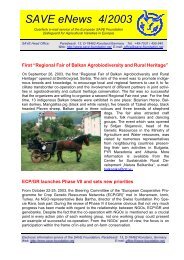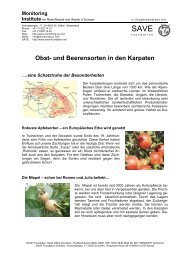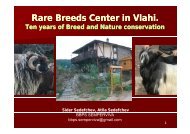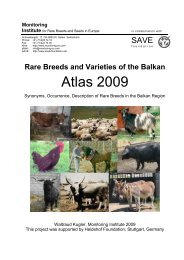Tiergenetische Ressourcen in Griechenland - Safeguard for ...
Tiergenetische Ressourcen in Griechenland - Safeguard for ...
Tiergenetische Ressourcen in Griechenland - Safeguard for ...
Sie wollen auch ein ePaper? Erhöhen Sie die Reichweite Ihrer Titel.
YUMPU macht aus Druck-PDFs automatisch weboptimierte ePaper, die Google liebt.
Anhang 3<br />
Monitor<strong>in</strong>g Institute i n c o l l a b o r a t i o n w i t h<br />
<strong>for</strong> Rare Breeds and Seeds <strong>in</strong> Europe<br />
Successful Conservation through an Animal-Loan-System<br />
50<br />
SAVE<br />
f o u n d a t i o n<br />
Secur<strong>in</strong>g the survival of endangered breeds through the support and management of small<br />
groups of animals is a method of conservation that has proved to be successful. The system, as<br />
practised by SAVE, works with three levels of actor:<br />
The SAVE Foundation provides the starter capital to buy or contribute to the purchase of the orig<strong>in</strong>al<br />
animals. The SAVE Foundation also provides the know-how and support required <strong>for</strong> the<br />
system to function correctly.<br />
A local or national breed organisation or NGO, with the support of SAVE, adapts the system to fit<br />
the local situation. They are charged with<br />
F<strong>in</strong>d<strong>in</strong>g and purchas<strong>in</strong>g suitable animals<br />
F<strong>in</strong>d<strong>in</strong>g suitable keepers<br />
Plann<strong>in</strong>g breed<strong>in</strong>g strategies and manag<strong>in</strong>g them<br />
Runn<strong>in</strong>g a herdbook <strong>for</strong> the animals<br />
Interested and committed farmers undertake the practical day-to-day care of the animals and<br />
benefit from the products and services the animals can provide.<br />
The last examples of a breed are collected together, where necessary they are purchased. They<br />
are then sorted <strong>in</strong>to breed<strong>in</strong>g groups <strong>in</strong> order to maximise the genetic basis available. These<br />
breed<strong>in</strong>g groups are loaned to <strong>in</strong>terested and committed farmers. To secure aga<strong>in</strong>st the risk of<br />
poor animal husbandry or disease and also <strong>in</strong> order to place as many males as possible, the<br />
groups are given to as many farmers as possible.<br />
The farmer has the use of the breed<strong>in</strong>g group <strong>in</strong> his care. Any milk, wool or meat etc produced is<br />
his own to use or sell. The Project reta<strong>in</strong>s the ownership of the breed<strong>in</strong>g group and the right to<br />
buy any off-spr<strong>in</strong>g <strong>in</strong> order to <strong>for</strong>m new breed<strong>in</strong>g groups and to promote population growth <strong>in</strong> the<br />
breed. This right to buy works under the pr<strong>in</strong>ciple of “first refusal”; only if the Project does not<br />
wish to purchase the off-spr<strong>in</strong>g can they be sold to third parties. Likewise, if the Project wishes to<br />
sell one of the animals it owns, the keeper of that animal has first refusal. The farmer may pay <strong>for</strong><br />
animals he wishes to own by giv<strong>in</strong>g a suitable young animal to the conservation programme.<br />
These rights are legally secured by all parties sign<strong>in</strong>g a contract to that effect.<br />
With the guidance of SAVE, a local or national breed organisation/NGO keeps a herdbook and<br />
manages the breed<strong>in</strong>g. This organisation ensures that the breed<strong>in</strong>g programme is fulfilled. They<br />
also meet with the farmer to decide which animals can be slaughtered. The slaughter of an animal<br />
must be <strong>in</strong> conjunction to another suitable animal be<strong>in</strong>g reared <strong>in</strong> its place.<br />
As soon as the breed<strong>in</strong>g population is stabilised, the breed can be released <strong>in</strong>to the free market<br />
and the tight controls can be relaxed. However, it is sensible if the manag<strong>in</strong>g NGO or breed organisation<br />
cont<strong>in</strong>ues to run a herdbook, cont<strong>in</strong>ues to own a nucleus group and cont<strong>in</strong>ues to plan<br />
the breed<strong>in</strong>g, preferably reta<strong>in</strong><strong>in</strong>g ownership of as many males as possible.<br />
This system can be adapted to meet local conditions. The options should be discussed by SAVE<br />
and the local/national breed organisation or NGO. Different regulations will <strong>in</strong>fluence who owns the<br />
animals and what contract is to be signed. There are many possibilities that can be considered <strong>in</strong><br />
order to f<strong>in</strong>d the optimal solution to any problems <strong>in</strong> implement<strong>in</strong>g this system.


